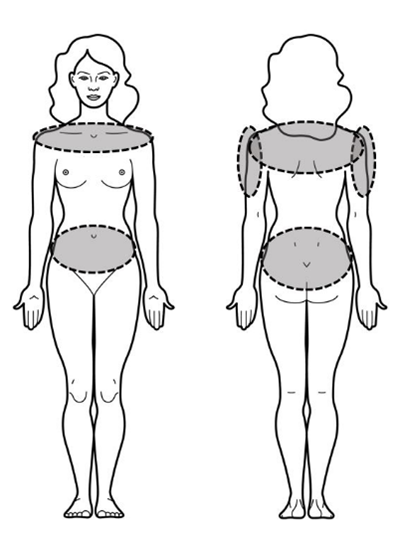Learning About the Birth Control Patch
What is the birth control patch?

The birth control patch is a thin, light-brown patch that’s worn on the skin.
The sticky part contains hormones (estrogen and progestin) that are like natural hormones. The hormones are absorbed through the skin and stop the ovaries from releasing an egg. You can’t get pregnant if you don’t release an egg.
How well does the birth control patch work?
- With typical use (this means not following the exact directions, for example you might be late changing your patch) the patch is 91% effective.
- With perfect use (this means you follow the exact directions all the time) the patch is 99.7% effective.
- The patch may be less effective at preventing pregnancy if you weigh more than 90 kg (198 lbs.).
- Most pregnancies happen because people don’t use their patches as directed.
- The patch doesn’t protect you from sexually transmitted infections (STIs) and HIV.
How do I start using the patch?
You need a prescription from your healthcare provider for the patch. Many sexual health clinics offer some types of birth control for free or low cost for people who qualify.
If you start the patch on:
- day 1 of your period, it works right away to prevent pregnancy.
- any other day, use an extra form of birth control (like condoms) or don’t have vaginal sex for 7 days.
How do I use the patch?
Put the patch on clean, dry skin on your upper buttocks, upper outer arm, abdomen, or upper body.
Put each new patch in a different place (for example, change between your right and left sides) to keep your skin from getting irritated.

Press down firmly on the patch with the palm of your hand for 10 seconds to make sure the edges stick well. Check that your patch is secure every day.
If your skin gets irritated, take the patch off and put a new one on in another place (your patch change day stays the same).
Only use 1 patch at a time and:
- Leave the patch on during activities (like when you exercise, shower, or swim).
- If a patch isn’t sticking or your skin is irritated, try to put it on again in a different place. If it won’t stick, take it off and put a new patch on right away. If you need a replacement patch, talk to your pharmacist or healthcare provider.
- Be aware that used patches still contain hormones. After removing a patch, fold it inwards so it sticks to itself and put it in a garbage that is out of a child’s or pet’s reach.
- Store your patches at room temperature (never put them in your fridge or freezer).
When you use the patch:
- Avoid putting any bath oil, body wash, lotion, or powder on the area where you will put your new patch.
- Don’t put the patch on your chest or breasts.
- Don’t put the patch on skin that is red, cut, or scratched.
- Never use bandages or tape to hold the patch in place as this affects how the hormones are absorbed.
When do I change the birth control patch?

Your patch change day is the day of the week that you put your patch on. Always put on a new patch on the same day of the week, at the same time.
You wear a patch for 1 week at a time and then remove it. A new patch is put on each week for 3 weeks in a row. You don’t put a patch on during week 4 (birth control hormone-free days). This is when you’ll get your period. Never leave the patch off for more than 7 days in a row.
After your 7 days without a patch, start a new package of patches and:
- Put on the first patch on the same patch change day.
- Put the patch on even if you still have your period—it should stop in a few days.
- Put the patch on even if you haven’t had your period and contact your healthcare provider. Consider doing a pregnancy test if you’ve had vaginal sex without a condom since your last period.
What are the benefits of the birth control patch?
- Your period may be more regular, lighter, or shorter with less cramping.
- The patch may lower your risk of getting ovarian and endometrial cancer.
- The patch may help with acne and painful periods (dysmenorrhea).
- It’s safe to use the patch for many years. There’s no need to take a break from using it.
- You can get pregnant as soon as you stop using the patch.
What are the side effects of the patch?
There is a chance (more likely in the first 3 months) that you might have:
- headaches
- breast or chest discomfort
- mood changes
- irritated skin where the patch is applied
- weight changes
- spotting or bleeding between periods
- changes in your period (heavier or lighter)
- upset stomach (nausea)
- bloating (from fluid retention)
If you have side effects, don’t stop using the patch. Talk to your healthcare provider. Most side effects get better within 3 months.
Can the birth control patch cause blood clots?
When using the patch, there’s a small risk of blood clots in the legs, lungs, heart, or head. The risk is higher depending on:
- your age
- your weight
- any history (or family history) of blood clots, heart attack, or stroke
- any history of smoking or vaping nicotine (especially people older than 35 who smoke)
- if you are less than 21 days postpartum
- any history of migraines with aura or other nervous system problems affecting speech, vision, movement, or sensations
- your risk factors for heart disease (like high blood pressure, diabetes, or high cholesterol)
- any history of other medical problems (ask your healthcare provider about this)
The risk of getting a blood clot with the patch may be higher than with the birth control pill. The risk of getting a blood clot is higher during pregnancy and right after having a baby than it is when using the patch.
If you get a fever or are exposed to heat (like a sauna or hot tub) with the patch on, you may get more estrogen. This may increase your risk of getting a blood clot.
Blood clots are very serious. Go to the nearest emergency room or call 911if you have:
- trouble breathing or it hurts to breathe
- a very bad headache
- sudden numbness in your face, arms, or legs (often only on one side of the body)
- very bad pain in your abdomen, chest, or legs
- one leg is swollen
- eye problems (like sudden blurry vision or loss of vision)
- sudden problems with walking or balance
- sudden confusion or trouble understanding what people say to you
What if the patch fell off, I forgot to put it on, or I forgot to change it?
- If you need help deciding what to do, talk to your healthcare provider, read the chart below, or use the Sex & U – Stay on Schedule tool. There are also apps you can use on your phone to help you remember to change your patch.
- If it’s less than 24 hours since the patch came off, try to put the same patch back on. If you can’t, put on a new one right away. Your patch change day stays the same and you’re still protected from pregnancy.
If you forget to put on or change your patch for over 24 hours |
| Week 1 | Week 2 or 3 |
Started more than 24 hours late or patch off for more than 24 hours | Patch off for 24 to 72 hours | Patch off 72 hours or longer |
- Put on a new patch right away. This cycle will have 3 patches.
- Your patch change day stays the same.
- Use an extra form of birth control (like condoms) or don’t have vaginal sex for 7 days.
- Get emergency contraception as soon as possible if your extra method of birth control fails (like if the condom breaks) or if you’ve had vaginal sex without a condom in the last 5 days.
| - Put on a new patch right away. Finish this cycle of patches and then start a new cycle of 3 patches. Don’t take the hormone-free break.
- Your patch change day stays the same.
- You might have spotting or miss your period this month. Don’t take off your patch.
- You are still protected from pregnancy.
| - Put on a new patch right away. Finish this cycle of patches and then start a new cycle of 3 patches. Don’t take the hormone-free break.
- Your patch change day stays the same.
- You might have spotting or miss your period this month. Don’t take off your patch.
- Use an extra form of birth control (like condoms) or don’t have vaginal sex for 7 days.
- Get emergency contraception as soon as possible if your extra method of birth control fails (like if the condom breaks) or if you’ve had vaginal sex without a condom in the last 5 days.
|
What else is important to know about consent, sexual activity, and birth control?
- You have the right to decide to have sex or not. Talk with your partner or partners about consent.
- There’s an 85% chance of becoming pregnant within one year if no birth control is used for vaginal sex.
- Use a condom or barrier every time you have sex (oral, vaginal, anal). Condoms help prevent pregnancy, STIs, and HIV.
- You can lower your risk of HIV by taking an HIV prevention medicine every day. Many Albertans can get it for free. Visit HIV PrEP to find out more.
- Transgender and gender diverse people who have a uterus can use hormonal birth control. It can help prevent pregnancy and make periods lighter and less painful.
Where can I find more information?
If you have questions, need to find a sexual health clinic near you, or want more information, call Health Link at 811 anytime, day or night, to talk to a registered nurse.
To see this information online and learn more, visit MyHealth.Alberta.ca/health/aftercareinformation/pages/conditions.aspx?hwid=custom.ab_birth_control_patch_inst.

Related to Sexual and Reproductive Health
For 24/7 nurse advice and general health information call Health Link at 811.
Current as of: February 12, 2024
Author: Sexual and Reproductive Health, Alberta Health Services
This material is not a substitute for the advice of a qualified health professional. This material is intended for general information only and is provided on an "as is", "where is" basis. Although reasonable efforts were made to confirm the accuracy of the information, Alberta Health Services does not make any representation or warranty, express, implied or statutory, as to the accuracy, reliability, completeness, applicability or fitness for a particular purpose of such information. Alberta Health Services expressly disclaims all liability for the use of these materials, and for any claims, actions, demands or suits arising from such use.
